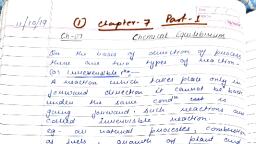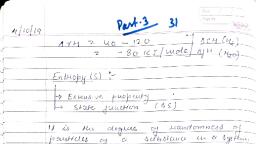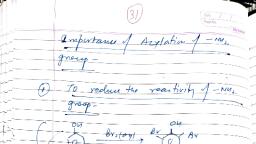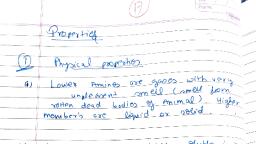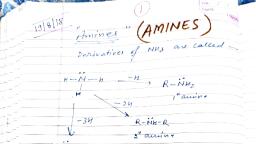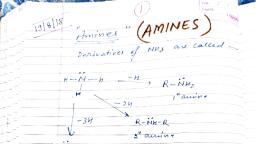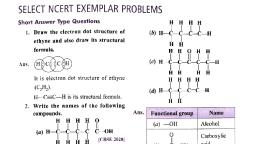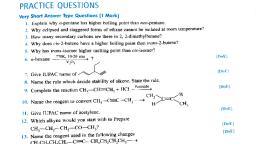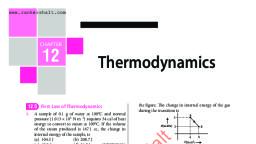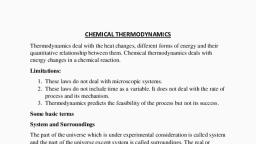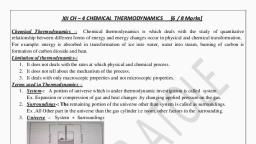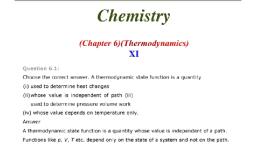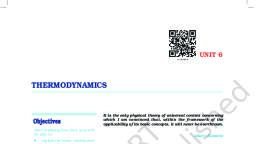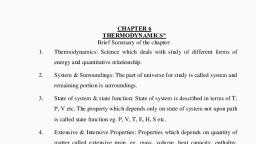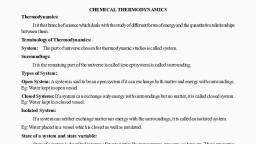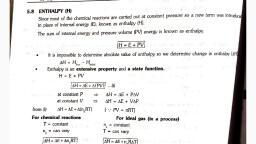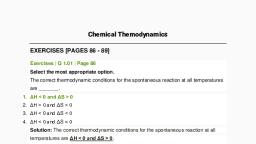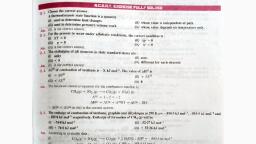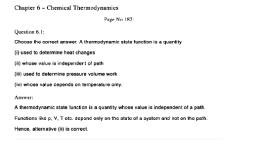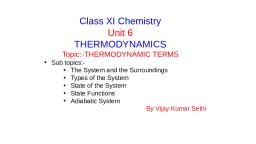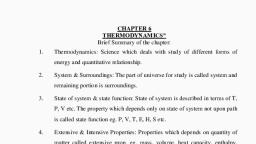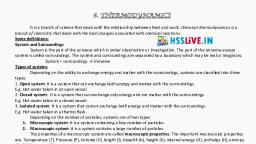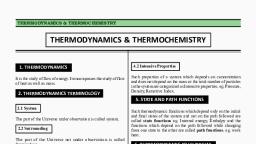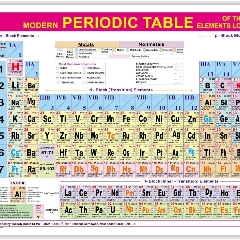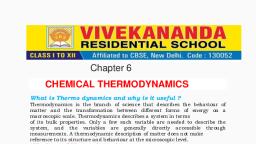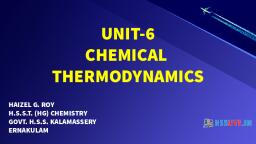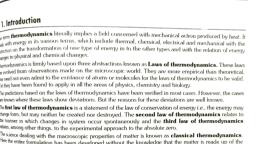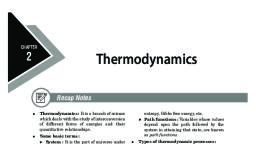Page 1 :
6, , CHEMICAL, THERMODYNAMICS, , CHAPTER AT A GLANCE, THERMODYNAMICS, Thermodynamic terms, , Applications, , Measurement of, , Enthalpy change, , Enthalpies for different, , AU and AH, , of a reaction, , type of reactions, , Work, , System and, , AU measurement, , surrounding, , Enthalpy, , Open system, , Standard enthalpy, , reactions, , of combustion AH, , AH measurement, , New state function, Types of system, , Standard enthalpy of, , Enthalpy change during, , Enthalpy of, , phase transformation, , atomisation AH, , Standard enthalpy of, , Extensive& intensive, properties, , formation, , Heat capacity, , Thermochemical, , Closed system, , Abond, equations, , Relation between, Hess's law of constant, heat summation, , C and C, , Isolated system, , Bond Enthalpy, , Lattice enthalpy, , Enthalpy of solution, , Enthalpy of dilution, The state of the system, , Spontaneity, , constant, , State function or state variable, , Decrease in enthalpy, , Pressure, Work: Adiabatic process, , Entropy& spontaneity, , Volume, Gibbs energy and, , Heat, , Temperature, , spontaneityy, Both work & Heat, , Amount (n) no. of, moles, , AU q+W, , are not to, , be studied for the, , Entropy& second law, of thermodynamics, , Absolute entropy & third, law of thermodynamics, , Internal energy as a state, function, , These topics, , Gibbs energy change, and equilibrium, , forthcoming, , examinations.
Page 2 :
IMPORTANT TERMS AND CONCEPTS, Chemical Energy. The, 1., , energy stored by the, molecules which is released, reaction is called chemical during chemical, energy e.g. CH,, butane, petrol burn in, presence of air and, liberate energy., 2. Mechanical, work. When fuel burns in, an, of, a, engine, vehicle, the chemical energy is, converted into mechanical, work., 3. Ther, modynamics. The science in, which we study, energy changes is called, , thermodynamics., , 4., , 5., , Systenm. A portion of universe which is under, investigation, e.g. portion of atest tube where, reaction takes place, is called, system., , Surroundings. Everything else in the univee*, except system is called surroundings, eg&, CXCept the portion of the test tube where, , reaction takes place is, surroundings, ie., and around the testtube., 6., , abovo, , Open System. The system which can exchang, , matter and energy with surrounding is called
Page 3 :
open system, eg. a spoonful of tea is an open, , system because it will become cold as well, its taste will change, i.e. it is exchanging, energy and matter with the surrounding., 7. Closed System. It can exchange energy but, not matter with surrounding. e.g. tea placed, in a closed kettle. It will become cold but its, taste will not change., 8. Isolated System. It can neither exchange, as, , Note:, , extensive property., () Internal energy is an, (i) It depends upon mass, temperature,, pressure and, , absolute value of internal energy o, substance cannot be determined., , (ii) The, a, , state function., experimentally determined at, , (iv) Internal energy is, , (v) AU can be, constant, , a, , volume with the, , help, , of bomb, , calorimeter., , heat nor matter with the surroundings, e.g., , (vi) U, , tea placed in thermos flask., , physical state of the system., , =, , RT mol, , for monoatomic gas., , 9. State of the System. A system is said to be in, , 13. Work. It is a mode of energy transfer if there, , definite state when its macroscopic properties, have definite values., 10. State Variables. The macroscopic properties, , the, is difference in pressure of the system and, If, surrounding till the pressure becomes equal., work is done by, system loses energy, it means, If system gains energy, it means, the, , of a system are decided by state variables, since change in any of these properties, cause, , the system to change into another state, e-g., , pressure, temperature, volume, composition., 11. State Function. Those thermodynamic, functions whose values depend upon initial, and find state of the system and not the path, are called state function e.g. AH (enthalpy, , change),, , AU, , (internal, , energy, , change), , 12., , depends upon initial and final states of, , the system and do not on the means; i.e. how, the state is reached, is called state function,, and AG are state functions., e.g. AU, AH, AS, (Intrinsic Energy). It is the, Internal, , Energy, , sum, can, , of all the forms of energies that a system, of 6 components:, possess. It is made up, , (i) Energy, , (i), , due to translational motion of, , molecules., motion of, Energy due to rotational, molecules., , (ii) Energy, , due to vibrational motion of, , molecules., , (iv) Bond energy., (v) Energy due to, , exchange, , and surroundings, i.e. q = 0., , Note:, , (i), , In adiabatic expansion of an ideal gas, the, internal energy of the system decreases, , and the temperature falls., , are, , state functions. The thermodynamic property, which, , system., , work is done on the system., 14. Adiabatic Process. The process in which no, of heat takes place between system, , (i), , In adiabatic compression of an ideal gas,, internal energy of the system increases, , and the temperature rises., 15. Heat. It is the energy exchanged between, Surroundings and system when their, temperatures are different., , Itg is positive heat is absorbed by the system., 16. Irreversible Process. The process is said, to be ireversible, if a change is brought out, , in such a way that the process could not be, , reversed by a infinitesimal change., , 17. Isothermal Process. The process in which, temperature of the system remains, , constant, , at each stage of the process, i.e. d l =, , 0, , or, , AT 0., intermolecular, , force of, , attraction., electrostatic force of, (vi) Energy due to, attraction between nucleus and electrons., It is denoted by 'U'., , 18. Thermal, , Equilibrium. Asystem is said to be, , in thermal equilibrium if no heat flows from, , part otf the system to another, i.e. when, temperature remains constant throughout in, all parts of the system., , one
Page 4 :
(1) When gas expands into vacuum, the s, work, done by it is zero since p 0,, , 19. Internal Energy Change. It is defined as heat, exchanged with the surroundings at constant, , =, , ., , volume, i.e. when the process is carried out, , in closed container., AU q + w, , (in) Duringisothermal reversible, expansion of, a gas, work done by, the gas is, , AU = q - pAV. If process is, , carried out at constant volume, then AV =0., AU =q (q is measured at constant volume)., , total energy of universe remains constant. The, , w, , and -ve, if heat, is +ve when work is done, , the, , is known, , 24. Free, , W, , as, , reversible process. It never leads, , expansion., , vacuum, , = q +w, , is mathematical statement of 1st law of, , The, , expansion of a gas in, , when there is, , no, , external pressure, , Pe0) is called free expansion., , .Nowork is done during free expansion of, , thermodynamics., q and w are not the state functions but, , an ideal gas., , +w AU is a state function., , () For isothermal process. AU, , =, , system., , (ii) For isochoric process. AV= 0,, , w pAV=0,, i.e. change in internal, , energy is equal to heat exchanged with, , surroundings at constant volume., , (ii) For adiabatic process. q = 0, AU =, , internal energy change is equal, to work done on the, system., Importance of First Law. It provides useful, information about energy changes in chemical, reaction., w, i.e., , Pressure-Volume Work (Mechanical Work)., , A system, containing gases undergoes, in volume in, of, , presence, , W, , It process is carried out at constant volume, , AV 0,, AU=4 (heat is supplied at constant volume, 1.e.process is carried out in closed container)., 25. Isothermal and free expansion of a, , gas. In isother-mal process, there is, no, W, , change in temperature (AT 0),, =0, Pext=0 in vacuum, q 0, therefore,, =, , =, , AU =0., , Isothermal irreversible change, AU =q t+ w, , 0 q+w, , change, externally applied, a, , -Pext AV, , pressure. 1he work done in this case is called, , pressure-volume work., , w=-p, (V-V), w -pAV,, where p is in atm, AV is in litres., 1 L atm= 101.3 joules., , Pext AV, , AU =q +w, AU =q-Pext Av, , 0,, , - w , ie. heat absorbed by system, is equal to work done by the, , 21., , on, , to completion., , U, =U, + qtw, , the, , when heat is, is evolved., Also, , change is carried out so slowly that the system, d surroundings are always in, equilibrium, , constant., , AU = 4, , maximum, , tve, , the system, and-ve when work is done by the system, 23. Reversible Process. The process in, which, , surroundings. (also called isolated system) is, , AU, , 1s, , absorbed, , energy of a system that is isolated from its, , U-U,, , conventions. q, , 22. Sign, , 20. First Law of Thermodynamics (Law of, , Conservation of Energy). It states that energy, can neither be created nor be, destroyed. The, , w= 0., , - Pextfinal, , Isothermal reversible change, , 9-w=2.303 nRT log, Adiabatic change q = 0, AU, , = Wadiabatic, , Vinitia
Page 5 :
26., , Enthalpy (H)., , It is, , defined, , content of the system. It is, of internal energy and, , as, , total heat, , equal to the sum, , heat measured at constant pressure, H =U+ PV, , pressure-volume work., , Mathematically, H U+pV,, where U is, , H U+ RT, , =, , internal energy., Absolute enthalpy of a system cannot be, , determined. H is a state function., Enthalpy Change (AH). It is defined as heat, , exchanged with the surroundings at constant, , H RT+RT, =, , RT mol, , for monoatomic gas., AH AU + AnRT, , pressure, i.e. when process is carried out in, , If An, , 0,, , AH AU, , open container., , I f An > 0,, , AH >AU, , I f An < 0,, , AH <AU, , In the following, expression, Hp is, of product,, is, of, , HR, is pressure, V, is, , volume, (V-V,), , enthalpy, enthalpy reactants, 'p', initial volume, V, is final, , is AVie. change in volume, , and R is gas constant 8.314, AU is internal energy change., U, is initial internal energy., , JK mol, , less stable than reactants because they have, , higher energy., , AH H-H=Hp-HR, , PVA nRT, , H, =U, tpPV, pVB nRT, , heat is given out to the surroundings is called, exothermic process. In this process, products, are more stable than reactants because, they, have lower energy., 29. Isobaric Process. The process which takes, place at constant pressure is called an isobaric, process, e.g. heating of water to its boiling, point and its vaporisation occurs at the same, , H =U, tpV2, PB PVA ("B-"A RT, , H-H, =U,-U,+p(V2-V), PVB-V =An_RT, AH, , surroundings. In this process, products are, , 28. Exothermic Process. The process in which, , U, is final internal energy., , and, , 27. Endothermic Process. The process in which, heat is absorbed by the system from the, , atmospheric pressure. Expansion of a gas in, an open system is also an example of isobaric, process in which dP or AP = 0., , 30. Isochoric Process. The process which is, , AU +pAV, , carried out at constant volume is called an, , pAV = An RT, , isochoric process, i.e. dV or AV = 0, e.g. AU, , AH, , AU+ (An) RT, , [pV= nRTpAV =An RT], , measurement at constant volume is isochoric, , process, , An=no. of moles of gaseous products-no. of, , 31. Extensive Property of a System. It is that, , moles of gaseous reactants, , property of a system which depends upon, the amount of substance, e.g. mass, volume,, pressure, internal energy, free energy, etc., , AH, , AU + A(pV), =, , AH, , AU, , +, , pAV, , +, , VAp, , AU +pAV, , AH = q -pAV + pAV, , [Ap= 0 at constant pressure, , AH 4p, , 32. Intensive Property of a System. It does not, , depend upon the amount of substance present, in the system, e.g. temperature, density,, , viscosity, refractive index, surface tension,, specific heat, etc.
Page 6 :
Note. In some cases, ratio of two extensive, , 36., , M, , mplmoletelya, , 33. Measurement of AU., , It is, , xcx AT,, , where m' is the mass of water, 'c' is specific, heat capacity and AT is change in temperature., At constant volume, AU, 4%, i.e. measured heat absorbed or evolved gives, , enthalpy (amount of heat reani T, to vapourise one mole of, liquid at co, and, standard, temperature, pressure (I har, var) is, called standard enthalpy of, change in, , =, , change, , at constant, , pressure, , molar enthalpy, , gives, , change in enthalpy., 34. Measurement of AH., Measurement, , H,O(), , atmospheric pressure) can be done by, calorimeter shown in fig., , of, , vapourisation, , vapourisation, A, , H,O(g); A,aH= +40.79, , mol-, , of, , (generally, , endothermic process, , HO()>H,O0, AuH=6.00 k, , change in internal energy., At constant pressure, AH, 4,, ie. measured heat absorbed or evolved, , an, , 37. Standard enthalpy of vapourisation.mor, , =, , heat, , fusion, TThe enthalpy, change, place when I, mole, substance in standa state, melts con ofsolia, is called standard enthalpy of, fusion, enthalpy of fusion, AiH e.g. or, , V, , m, , of, , that takes, , properties will be an intensive property, eg, d=, , Standard enthalpy, , It is also, , an, , endothermic process., , 38. Standard enthalpy ofsublimation (A, it is, , defined, , as, , enthalpy change when, , one, mole of solid substance sublimes, directly into vapours without becoming(changes, liquid), at constant, temperature and under standard, , Thermometer, , pressure e.g., , Co)Cg) AH = 717 kJ mol, Foamed polystyrene, cup, , AubH-RH+A, 39. Standard, , enthalpy of formation: It is, enthalpy change when one mole, of a compound from its elements in their, most stable states, (standard states or reference, defined, , Reaction mixture, , as, , states) is called standard molar enthalpy of, , AH, , 'm, , formation. A,H. eg., , 4p, , Hg)+0,, (g)H,0(), 2, , pmxcxAT, is mass of water,'c is, specific heat, , capacity,, charge in temperature., Standard enthalpy of reaction. It is defined, as enthalpy, change ofa reaction when all, reactants and products are in their, standard, states i.e. natural state in which, they exist at, , A,H=-285.8 kJ mol"., , AT is, , 35., , 298 K and pressure 1 bar, e.g. pure ethanol is, liquid under standard conditions. It is denoted, by AHS., , 4,, , Thermochemical Equation., , A, , balanceo, , chemical equation together with t, designation of its value of AH and phySia, , states of reactants and products is called, , thermochemical equation,, eg, , Hg)+, , 0,g), , H,O0, , mol, 4,H° -286.0 kJ
Page 7 :
Chemical T nermodyild, , in their standard, , The negative sign of AH indicates that it is, , and products, , exothemie process., , specified temperature eg, , The reverse reaction would roquire the absorp-, , tion of 286 kJ mol, , eg HO0)H8)+0,(, AH-, , +286.0 kJ mol, , Thus, the reactions which are endothermic, in forward direction are exothermic in the, reverse direction. It is according to the law, of conservation of energy., 41. Hess's Law of Constant Heat Summation. It, states that the enthalpy change of the reaction, remains the same whether reaction is carried, out in one step or several steps,, , C(s) +0,8g)> CO,lg):, AH, =- 393 kJ mol, , 1, , Co)0,)C0g)AH, =- 110 kJ mol, , +, , 44., , defined, , as, , Enthalpy of Atomisation. It is, mole of substance, enthalpy change when one, is broken up into its isolated, , atoms, , in the gas, , phase. It is denoted by AH, e.g., , Na(s), , AH, , > Na(g), , 108.4 kJ mol, , =, , 45. Bond Enthalpy. It is the amount of energy, in one mole ofa, necessary to break bonds, substance to form products, gaseous covalent, , in gaseous state,, , Hg)2H(g)%, AH° 435.0 kJ/mol, , 46. Bond Dissociation Energy. It is defined, enthalpy change involved in breaking the, , bond between atoms of gaseous homonuclear, molecules (eg. H2. Clz, O, etc.)., Bond energy of diatomic molecule is equal, , to its bond dissociation energy. In polyatomic, , cOg)+0(g)->CO,8), AH,=- 283 kJ mol, , molecules, bond enthalpies are defined as, I mole of, average energy required to break, , particular type of bond, , C(s)+O,(g)->CO,(8), , AH=, , AH, = AH, + AH, , in various molecules., , bond enthalpies (reactants), , Adding ()and (i),, AH-393 kJ mol, , states at, , CO,(g) 2H,O(), CH (g)+ 20,(g), AH, 890.3 kJ mol, , e.g, , eg, , are, , -, , bond enthalpies (products), , 47. Mean bond enthalp). It polyatomic molecules, ike CH, the energies required to break the, , Applications:, to determine AH, , i)It is used, , reactions which, , cannot, , of those, , be determined, , enthalpyeg, , experimentally, to determine AH of those, , (ii) It is used, , reactions which take place very slowly., , 42. Cycic Process,, , In, , cyclic process, the system, , goes through a, given, different processes, but in the end,, , in, , state., , returns to, , dE, , enthalpy change when I mole, of, of substance burns completely in excess, and all reactants, oxygen to form products, is defined, , as, , CH,(g), , CH,(8)+ H(g), , Ahont=+427 kJ mol, CH(g), , CH,(w) + H(g), , pond, , series of, , or AU 0, dH or AH 0., It, Standard enthalpy ofcombustion( \,)., its initial, , 43., , state, , a, , individual C-H bonds in each successive, step ditfer, in such cases we use mean bond, , CH,(g), , CH(g), , +, , 439 kJ mol, , CH(g) * H(g), , Abougt, C(g)+H(g), , +452 kJ mol, , t347 kJ mol, ADond, Therefore, CHg)> C(g)- 4H(g), , AH=1665 kJ mol
Page 8 :
Mean bond, , enthalpy, , (v)Combination of oppositelyly, , of C-H bond, , x1665, kJ mol, 4, , crystal, , 416.25 kJ mol, 48. Lattice, Enthalpy. It is defined as enthalpy, change when 1 mole of crystal completely, changes into isolated particles in gas phase., e.g., ALatticeH= 788.0 kJ mol, 49. Born-Haber, Cycle. This method is based on, Hess's Law. Let us consider, energy changes, in formation of NaCl from, metallic sodium, =, , NatCl(s), , Na(g)+Ci(g)The, , Na(g), , 4., , 50., , required is called sublimation, , (ii) Dissociation of chlorine molecule into, chlorine atoms. This step requires energy, per mole of, , chlorine is called bond dissociation, , It is used for, , CIe), , (iii) Conversion of gaseous atom into gaseous, , cation. The energy required in this, process is called lonisation Enthalpy, , (I.E.)., , Na(g) + I.E., , Na (g) + e, , (iv) Conversion of gaseous chlorine atom, into gaseous anion., , CI(g)+e, , >CI(g) + E.G.E., , This step involves release of, energy, which is transferred to as electron gain, , enthalpy (E.G.E.)., , calculation, , of, , gain, , sublimation, , and bond dissociation, , enthalpy., , Enthalpy of lonisation (A,H). It is defined as, , enthalpy change to convert, , I mole of atoms in, are in gas, phase,, , ionised state, all the species, , A H E ionisation energy)+RT, eg K(g)K"(g) e;, >, , +, , AH° = 414.2 kJ mol, , energy (enthalpy). (D), , 2C(g), , of, , It is, , enthalpy, , energy per mole., , CL)+D, , energy, , enthalpy., , of metallic sodium into, gaseous sodium atom., , ClLe)+D, , Born-Haber Cycle:, , used to calculate A, H° values., 3. It is used for calculation of, electron, , 2., , (i) Conversion, , required, , of, , 1. It is used to calculate lattice, ionic solids., , NaCI(s);, , and the energy, , sum of energy, , Applications, , Steps:, , The energy, , NaCI(s)+U, , -S+D++I.E. +E.A. +U, , and chlorine gas., , Na(s)+ sublimation energy(S), , as, , changes, place, during various steps 1s equal taking, to, A,H°, the, heat of formation of, NaCl(s)., , Nag) +CI(g):, , Na(s)+C1(8), AH =?, , charged, , aseous ions to forr, solid, involves release of, energy known, lattice energy (U)., , 51., , Electron Gain, , Enthalpy., , It is defined, , as, , enthalpy change when 1 mole of anions are, formed from atoms, all, state,, , e.g, , species, , in, , gaseous, , CI(g) + e>Ci(g), , AegH=-348.6 kJ mol, It is denoted, , - RT, , by AH° =- A(electron efinity), , 52. Enthalpy of solution (A, H).It is defined as, , enthalpy change when one mole of substance, dissolves in specified amount of solvent., , AsoHAatice H+ Anya, It is endothermic for most of ionic compoun, that is why solubility of most salts, , with increase in temperature., , incre
Page 9 :
53. Enthalpy of hydration. The enthalpy change, when one of anhydrous salt combines with, required number of water molecules to form, , hydrated salt e.g., , 58., , which, Entropy. It is thermodynamic property, measures, , The, , more, , randomness, , or, , disorder of a system., , disorder or randomness, the, , higher, , will be entropy, eg. solid < liquid < gas., , CuSO)+5H,O()CusO,5H,O0s), , AyH-78.2 kJ, , In general, this process is exothermic but, there are some cases in which hydration is, , endothermic process., , i.e. it, , Entropy of a system is state function,, states of the, depends upon initial and final, , system. When the state of a system changes,, , the entropy also changes., , AS, , 54. Enthalpy of solution at infinite dilution. It is, , re=A, T, , enthalpy change when 1 mole of substance is, dissolved completely in an infinite amount of, solvent when force of attraction or repulsion, , T, where q is heat supplied isothermally and, is absolute temperature., , (ineractions) between ions are negligible., , For, , 55. Enthalpy of dilution. It is defined as enthalpy, , change when more amount of solvent is added, , a irreversible, , AS +ve, , For, , a reversible change, , to solute i.e. concentration of solution chanes, , AS 0, , e.g, HCIg)+10H,O(), , Entropy, , HC1.10H,0, AH=-69.01 kJ/mol, , HClg) +2SH,O(), , HC1.25H,OO, AH=-72.03 kJ/mol, , HCI(g)+ 10H,O+15H,O(0>HC125H,O, AH =-72.03 (-69.01), , =, , -3.02 kJ/mol, , 56. Spontaneous Process. The process which, can proceed either at its own or after proper, initiation is called spontaneous process., 57. Is decrease in, , enthalpy, , a, , eriterion for, , spontaneity. On the basis of enthalpy change,, exothermic processes should be spontaneous, be, but endothermic processes should not, , sponaneous., There are many endothermic processes, , which are spontaneous e.g. evaporation, , spontaneous process, at, , equilibrium, , increases with increase in, , temperature,, temperature., , decreases with decrease in, , 59. Disorder and Entropy., I n evaporation of water there is increase, , in the energy of molecules and process, is endothermic but this leads to greater, , disorder amongst water molecules in the, vapour state as compared to the liquid, state., , The disorder is the manifestation of, another thermodynamic property called, entropy and is represented by the symbol, , S). It is state function like internal energy, (U) and enthalpy (H)., The entropy change, AS is given by the, , equation:, , AS reY, T, , of water., , where rev is the heat absorbed when, , There are many exothermic process, , which do not take place at a particular, , the process is carried out reversibly and, isothermally (i.e. at constant T). If is, , temperature., It means on the basis of enthalpy change alone,, , expressed in joule (J) and temperature, in kelvin (K), then entropy change is, , we cannot decide spontaniety of the process., , measured in J K-., , °q
Page 10 :
Application: We, , The AS is state function because it is, , entropy, , independent of path., , iT s, , a measure, , ofincrease, , in disorder, , AG is measure of, , spontaneity of a chemical, , ground that the absorption of heat into, system leads to the vigorous movement, , reaction., , of the molecules due to increase kinetic, , Gibbs energy change which is based, on, its relationship to usetul work other, than, han, pressure-volume work that is obtainable from, , absorbed at higher, , in denominator., , ,, , ie. Tis, , the process that can be converted into useful, work. It is a measure of capacity to do useful, , process., In case of galvanic cells, Gibbs, energy change,, AG is related to electrical work done the, by, cell. If E is the e.m.f. of the cell and n mole, , work., , change, , where G is a state function., in free energy. AG AH -TAS, =, , is Gibbs Helmholtz, , of electrons, , equation. If AG is-ve,, , will be, , process is spontaneous when AG = 0, the, , equal, , standard states:, Here, , ASgurrounding0, i.e. ASTotal0, , pure substance, , can, , be, , entropy of, , determined, , at room, , temperature by virtue of third law. It is defined, as entropy of the substance, in its standard, state at 298 K and 1 atm, , pressure., , 63. Third Law of, , of a perfectly, zero kelvin., , where 'F' is, , Faraday, , Thermodynamics. The entropy, , crystalline substance is zero at, , 65., , products, , are, , in their, , AG-nFEell, , taking place, , The absolute, , to nFE, , If the reactants and, , 61. Second Law of, Thermodynamics. The, of, universe, is continuously increasing, entropy, due to spontaneous process, in it., , Entropy., , involved, the electrical work, , A,G-nFEcell, , process does not take place., , Absolute, , are, , constant. Thus,, , process is in equilibrium. If AG is tve, the, , system, , Wmax, , =, , spontaneously can be utilised for performance, of work. The greater the Gibbs, energy change,, the greater work can be obtained from, the, , Energy. It is defined as maximum, amount of energy available to a system during, , AG is, , m, , (for a reversible change at constant T and P), Thus, in principle, any process that occurs, , placed, , 60. Gibbs Free, , H TS,, , aspect of, , can, , i.e. -AG, , T, , very useful, , There is another, , process., , temperature., This is because, AS, , is, , be shown that Gibbs, energy for a, process is equal to maximum possible useful, work that can be derived from the, It, , it becomes more disordered than when the, amount of heat is, , property, , the system., , If the heat is absorbed at low temperature,, same, , This, , to chemists., , system absorbs, the more disordered it, becomes., , a, , absolut, , 64. Gibbs Energy and Work., , energy. In other words, the more heat the, , 62., , determine, , of substances at any other, tempea, , except OK according to third law., , of the system. This can be justified on the, , G, , can, , Eell, , is standard cell, , potential., Gibbs Free Energy Change and, Equilibrium, Constant., , Gibbs energy, , change should be negative, , for the chemical reaction to occur. During, the course of reaction, Gibbs energy, , decreases and composition of reaction, mixture changes with time and finally., a constant composition of a mixture 15, , obtained.
Page 11 :
In order to make these ideas, we, , must consider Gibbs, , quantitative, , energy change,, AG and standard Gibbs energy change., AG. Here, A,G° is difference in the, standard Gibbs energies of formation of, products and reactants both in standard, states., , AG°, , EA,G(prodoucts), , the value of AH°may be large and positive., In such, , case,, , value of K will be much, , smaller than I and the reaction is unlikely, to, , form, , in, , product, , large, , amount., , of exothermic reactions, A,H° is, to, large and negative and 4,G° is likely, cases,, be large and negative too. In such, In, , case, , K will be much larger than I and products, , -ZA, , , reactants), , Similarly, A,G is the Gibbs energy change, of a reaction at fixed composition of, reaction mixture., The Gibbs energy of reaction A,G is, , formed will be in large amount., , We may expect, reactions to have, , strongly exothermic, large K, and hence can, , go to near completion., We, , can, , determine the value of, , AG°,, , if, , value of K is known (or vice-versa)., , related to the standard Gibbs energy A,G°, of reaction, , by the equation:, , ve, , where Q is reaction quotient and R is, the gas constant, with the values 8.314 J, mol. If the species are gases, these, concentrations are expressed in partial, , K, , +ve, , ve, , temperatures., + ve, , ve, , +ve, , expressed, , but reverse, reaction will be, , in terms of, , spontaneous., , molar concen-tration as Q, At equilibrium, Q=Kand therefore, above, , ve, , ve, , ve, , (at low, , equation becomes, , 0, , Non-spontaneous, at all temperature, , and if species are in solution, reaction, will be, , Reaction will be, spontaneous at all, , pressure and reaction quotient willbeQ, quotient, , Description, , AH A,S 4,G, , A,G= A,G° + RTln Q, , low temperature., , T), , A,G° + RT In K, , Reaction will be, Spontaneous at, , +ve (at Reaction will be, , A,G°-RTIn K, , or, , A,G°- 2.303, , or, , RT, , high T), , Equation (i), , can, , also be written, , at high, , log K, .(i), as, , non-spontaneous, temperature., , +ve, , +Vve, , + ve (at Reaction will be, , lowT), , non-spontaneous, at low, , K, , =e4,GRT, , =, , 10-4G2.303RT, , temperature., ve (at Reaction will be, , high T), , We also know that, , spontaneous at, , high temperature., , A,G° = A,H° - TA,S, , The term low temperature and high, = - RT In K, , Since, , upon the value of, endothermic reactions,, , A,G° depends, , AH°, for strongly, , temperature are relative. For a particular, reaction, high temperature could even, mean room temperature.



